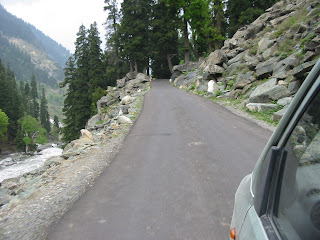Flaminco? Flamingo? Flamenco!... Flamenkarnatic

Flaminco? Flamingo? Flamenco!
"Spanish Flaminco Kalaripayattu Fusion" and "Spanish Flaminco Carnatic Fusion", reads the grand Kerala Sangeet Natak Akademi announcement about an event that was scheduled to take place at the Co-bank Auditorium in Thiruvananthapuram, during the recently concluded IFFK 2013.
Having heard of the Spanish Flamenco, and with suitable expectations, we seated ourselves; among other 'expectant' audience. On stage was just the traditional lamp.
Item Number 1: The singer has a mike, but he stands close to the dancer
and, cheek-to-cheek, he chants a few mantras. There are no props on stage, but the 5-ft traditional brass lamp that both artistes light together. The dancer’s
costume is a simple 2 piece garment, and her style is a mix of Bharathanatyam
and Kathakali.
Item Number 2: The dancer has changed into a flowing gown; a Spanish guitarist and drummer join them on stage. The singer croons Tulasi-daLa mula in a format nowhere near the classic rendition of that popular Tygaraja kriti. The dancer’s routine includes several mudras, footsteps, and yoga postures. The anupallavi is followed by a Spanish song, and the kriti resumes. The dancer has now adjusted her gown length, and performs more steps with a new prop: a cape-like shawl.
Item Number 3: The next piece is a Hindi bhajan. The slim dancer is now
attired in an off-white skirt and half-blouse, and she performs more steps that
reveal well-rehearsed combinations of classic hand gestures and dance steps.
About the performance:
“The Voice of the Body is a
performance by the Spanish dancer Mónica de la Fuente and Ravi
Prasad, a musician and artistic director from Kerala, in which an
invisible thread intertwines two bodies on stage that vibrate in unison. Breath
becomes sound, voice and song, movement, gesture and mudra. The show explores
the seed that evokes each emotion, weaving voice into body in search of the
connections between voice and body. The invention of new vocal codes shapes new
contemporary languages, sounds that illustrate each tension or action created
by the movement of different forms of expression. Movement flows among
classical codes of the performing arts of India and the spontaneous creation of
others.
In this space for exploring the various
languages of both sound and movement, connections and unexpected encounters
take place which allow the richness of each expression to be savoured and
reveal the paths of cultural encounters. Flamenkarnatic stems from the
encounter and exchange between artists from India (Ravi Prasad) and Spain
(Mónica de la Fuente as dancer, José Salinas as singer and Carlos Blanco on the
guitar) who, rather than create a ‘collage’ of virtuosity, seek to delve into
the deepest roots and find these expressions which are the ‘mothers of the
dance and music of all ages’, as García Lorca stated. This concert is an
intercultural journey undertaken by the gypsy tradition of Flamenco in Spain
into its Indian roots along a path that returns to the south of India in an
emotional encounter between Flamenco music, voices, Carnatic and Hindustani
compositions and Flamenco dancing techniques.”
(Apparently, the show premiered in
2012 in India. See “Twain in tune”. There is no post-performance review
though. Why?)
So now you know. That we witnessed neither flamingos in flight nor the Spanish Flamenco. But why did the KSNA, not pay attention to this by-no-means-small detail in their announcements?
So now you know. That we witnessed neither flamingos in flight nor the Spanish Flamenco. But why did the KSNA, not pay attention to this by-no-means-small detail in their announcements?
For the other fusion - between a Spanish art form and an Indian martial art form, see "First theater performance of "Atma Malabar" at IFFK 2013"


Comments
Post a Comment
i appreciate that you have some thoughts to share, and are taking the effort to do so.